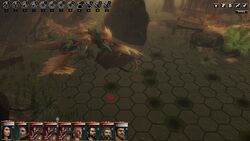Rampant Coyote on "Technical Dungeons"
Rampant Coyote on "Technical Dungeons"
Editorial - posted by Crooked Bee on Wed 29 February 2012, 08:05:33
Tags: Dungeons; Rampant GamesRampant Coyote brings a matter of utmost importance to attention in his blog post on the lost art of making the dungeon itself a non-trivial challenge in a CRPG. He even has a term for dungeons that abuse you with style, "technical dungeons":
Read on.
One thing the coyote fails to mention are teleporter mazes. Mmm, teleporter mazes. Along with shifting walls, trap rooms and turntables, they are definitely the way to go if you don't want your dungeon to be too banal. But I think I can forgive the rampant one for not mentioning that. After all, he's one of us. Don't you long for a CRPG in which, if the enemies don't get you, the dungeon itself will? I know I do.
I don’t know how to define it yet. You get it in many roguelikes and old-school western RPGs. You don’t get it in most JRPGs or modern non-indie RPGs. Darklight Dungeon Eternity has a lot of it (thus my pondering on this matter). Frayed Knight: The Skull of S’makh-Daon has less of it than I’d like. Ultima V had it. Ultima VI, not so much. Ultima VII had very little of it. Ultima Underworld, Dungeon Master, the Eye of the Beholder games – they had it in spades. From accounts, Wizardry IV had way too much of it to be any fun at all except to masochists. But all of the Wizardry games had plenty of it, up until Wizardry 8, which didn’t have very much of it in spite of plenty of dungeon crawling. The Elder Scrolls games had tons of dungeon crawling, but didn’t really have much of it either that I could feel.
What I’m talking about is the technical, analytical approach to navigating a dungeon. It’s a point where the dungeons of a game become more than just a setting where the game and story happens, and more than just a path between combat and puzzles. It’s where the dungeon itself is becomes an obstacle, encounter, or character in the game in its own right, offering explicit or implicit clues to its own nature. Where navigation of the dungeon requires a constant weighing of risk and reward. They can be automapped, but the map may actually need to be studied by the player from time to time to determine how to get to where he wants to go, or to figure out its secrets. A technical dungeon is decidedly non-linear, and is not something that will usually be "defeated" in a single session. While any old dungeon may contain combat, traps, puzzles, and secrets, in a technical dungeon these are not stand-alone elements.
What I’m talking about is the technical, analytical approach to navigating a dungeon. It’s a point where the dungeons of a game become more than just a setting where the game and story happens, and more than just a path between combat and puzzles. It’s where the dungeon itself is becomes an obstacle, encounter, or character in the game in its own right, offering explicit or implicit clues to its own nature. Where navigation of the dungeon requires a constant weighing of risk and reward. They can be automapped, but the map may actually need to be studied by the player from time to time to determine how to get to where he wants to go, or to figure out its secrets. A technical dungeon is decidedly non-linear, and is not something that will usually be "defeated" in a single session. While any old dungeon may contain combat, traps, puzzles, and secrets, in a technical dungeon these are not stand-alone elements.
Read on.
One thing the coyote fails to mention are teleporter mazes. Mmm, teleporter mazes. Along with shifting walls, trap rooms and turntables, they are definitely the way to go if you don't want your dungeon to be too banal. But I think I can forgive the rampant one for not mentioning that. After all, he's one of us. Don't you long for a CRPG in which, if the enemies don't get you, the dungeon itself will? I know I do.
There are 10 comments on Rampant Coyote on "Technical Dungeons"














